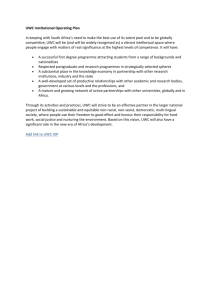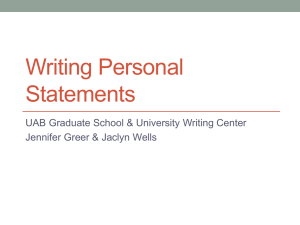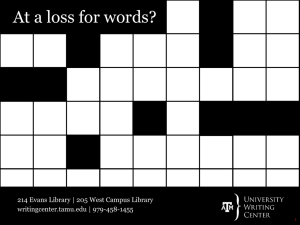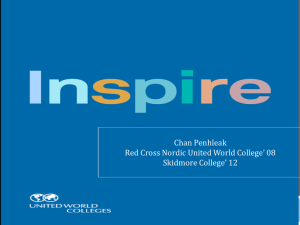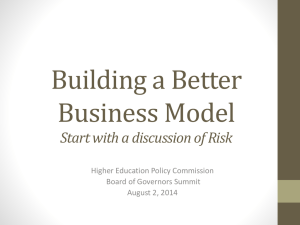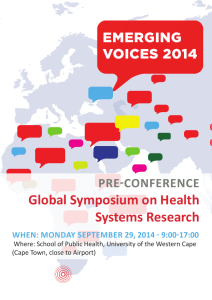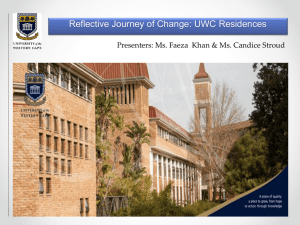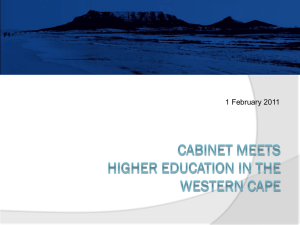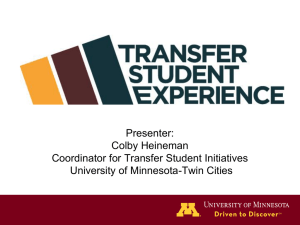Middleton rights and responsibility of students
advertisement
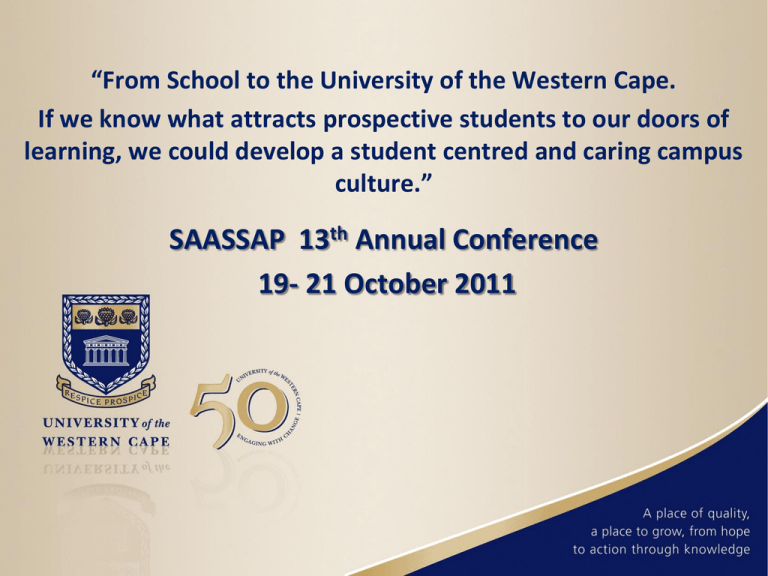
“From School to the University of the Western Cape. If we know what attracts prospective students to our doors of learning, we could develop a student centred and caring campus culture.” SAASSAP 13th Annual Conference 19- 21 October 2011 Introduction The paper addresses the factors and marketing information that influence prospective students to pursue tertiary studies and to select the University of the Western Cape as their preferred higher education institution; and how these choice factors could inform the student marketing and recruitment strategies and new students’ entry and orientation to the UWC campus environment in order to develop a student centred and caring campus culture. Dearth of local literature -> speculation Reasons-> choosing tertiary studies in general and the University of the Western Cape -> largely untested While UWC’s ‘struggle history’ was a strong attraction in the past, it may not be a critical consideration by the current cohort of undergraduate students. Research Objectives The research addresses three key questions. • What factors motivated prospective students to consider tertiary studies? • What factors motivated prospective students to consider UWC? • What marketing media informs prospective students about UWC? Process of decision-making The decision to enter higher education often involves several processes and a series of successive decisions which include a decision on particular programme/s of study and institution/s, and finally results in application/s, selection and subsequent enrolment (Cosser and du Toit, 2002). Models of decision-making • Economic models focus on the individual characteristics of students as consumers , cost-benefit analysis • Sociological models focus on the identification and interaction of variables that influence / predispose students’ decisions • Information processing models explain student choice behaviour by combining indicators in the economic and sociological models Four models of IPM have dominated the research on student choice during the 1980s David Chapman Model of Student College Choice (1981) Identified specific student characteristics which interact with external influences institutional characteristics institutional effort to communicate with students The Jackson Model (1982) preference stage exclusion stage evaluation stage Hanson and Litten (1982) aspiration commencement of the search process information gathering submission of application Enrolment Hossler and Gallagher (1987) predisposition stage search stage choice stage Choosing a HEI Main Choice Factors - International Studies USA studies quality and responsiveness of staff (helpfulness and accessibility) research activities social life opportunities economic considerations (location of campus and work opportunities) campus size (Bajsh and Hoyt, 2001; Espinoza, Bradshaw and Hausman, 2002, in Wiese, van Heerden, Jordaan and North, 2009). United Kingdom details of course and field of study (academic programme) price, place (diversity and campus accommodation) reputation of institution (Maringa, 2006 cited in Jordaan and Wiese, 2010) Australia career preparation specific academic programmes academic reputation distance from home library resources the quality of the research programme (Martin 1996; James 1999). Main Choice Factors – South African Studies Choosing to enter HE Intention to enter higher education, listed below in order of importance (Cosser and du Toit, 2002) Rank 1 2 3 4 5 6 7 8 9 10 11 12 13 14 Cosser and du Toit (2002) HE enhancing employability Intrinsic interest in a field of study HE leading to higher income Family urging HE study Offer of a bursary Family urging HE study to support learner and for themselves Ability to finance study through NSFAS Offer of a scholarship Ability to finance study through a bank loan Teacher urging HE study Classmates intending to enter HE Being unsure about direction in life Parents having money to finance HE study Romantic attachment Several similarities and a few stark differences Mean 4.4 4.1 3.9 3.8 3.5 3.5 3.3 3.2 3.0 2.9 2.8 2.7 2.4 2.1 Rank 1 2 3 4 5 6 7 8 9 10 11 12 13 14 15 16 17 18 19 20 21 22 23 Cosser and du Toit (2002) It has a good reputation The school/ faculty/ department in which I want to study has a good reputation It is far away from home, and I want to live in residence / other accommodation while studying There are better sporting facilities there than other universities/technikons The fees are lower than at other universities/technikons My friends recommended it to me It allows me to study via correspondence It is near my home, where I want to live while studying My parents / relatives studied there I have been awarded a scholarship to study there Mean 4.3 4.2 3.2 3.1 2.8 2.5 2.4 2.4 2.1 1.8 Wiese et al. (2009) Quality of teaching Employment prospects (possible job opportunities) Campus safety and security Mean 4.51 4.45 Academic facilities (libraries and laboratories) International links ( study and job opportunities) Language policy Image of higher education institutions Flexible study mode ( evening classes and use of computers) Academic reputation (prestige) Wide choice of subjects / courses 4.21 Entry requirements Links with the industry Fees (costs) Financial assistance (bursary and loans) Location of higher education institutions Attractiveness of campus Multi-cultural/diversity Social Life on campus On-campus/ Hostels Sports programmes Friends went there Brother/sister went there Parents went there (tradition) 3.75 3.71 3.70 3.69 3.69 3.51 3.35 3.17 3.12 2.69 2.35 1.93 1.83 4.33 4.18 4.05 4.04 4.02 3.99 3.97 Marketing implications for HEIs Jordaan and Wiese (2010) suggest Black African and White students different needs and -> unique marketing -> diversity in the HE system. Recruitment strategies and communication messages: Black African students: multi-cultural climate at the institution White students: social factors such as sports programmes, social life on campus, attractiveness of the campus and on-campus housing We do not necessarily agree with this finding and suggest that the communication messages rather than the marketing strategy should be adjusted to hone into the needs and perceptions of different prospective student groups. Comparisons SA and International Studies Overall, the findings of SA studies (support some of the international and local findings. United States : Beauty of the campus, good sporting facilities and the reputation of a prestigious institution. In this study, however, campus attractiveness ranked only 16th, while sporting programmes were ranked 20th. Hoyt and Brown (2003 in Wiese et al 2009): academic reputation, quality of faculty and instruction and employment opportunities as important choice factors. Australia: Martins, Loubser and Van Wyk (1996 cited in Wiese et al 2009): career preparation, specific academic programmes, distance from home, academic reputation and library resources. The results of the Wiese et al studies support the findings of Coetzee and Liebenberg (2004 cited in Wiese et al 2009), in that academic reputation and image are viewed as important choice factors. However, location, friends and sporting programmes were not indicated as very important factors by the respondents in this study. Research Methodology UWC OSD Pre-entry Attribute Survey 2006-2010 with new, first year, undergraduate students. Self-administered questionnaire Piloted with a group of 20 students in 2005 The questionnaire used a five-point Likert-type scale ranging from 5 = very important and 1 = can’t say. The results reported are indicated as “very important and important” were collapsed. The survey was quantitative utilising a non-probability, purposive method of sampling. On average, 40% of first year students completed the survey during Orientation Week prior to their first lecture. Respondents accepted into University were exposed to campus culture but not immersed in it. Establish a trend of factors relating to students’ decision to enrol for tertiary studies and their choice to attend UWC. Test of significance yet to be undertaken. Research Findings • • • • • 40% of population participated 80% of respondents from High School Gender: 60% Female 40 Male Race: Black African: 35% Coloured: 60% Language: Home Language 45% English 23% Xhosa 20% Afrikaans Indian, White and Other: 5% High School Language 75% English 20% Xhosa 3% Afrikaans • 70% from Urban Areas • 75% attended Public High Schools Preferred Language 80% English 10% Xhosa 2% Afrikaans Social and Cultural Capital • • • • • Mother and Father’s level of educational qualifications has been increasing up to tertiary level 50% had concerns about fees 50-50 distribution fees will be paid between family and bursary/loans Family monthly income: 25% > R20000.00 40% < R 5000.00 50% described Grade 12 teachers as motivated and hardworking UWC • • • 35% indicated family and siblings have graduated from UWC 22% indicated siblings are currently studying at UWC or another institution Advice of significant others contributed to decision to study at UWC Family 55%, Friends 35%, Teachers 40% Marketing and Recruitment • 65% indicated they learnt about UWC through family and friends • 55% use public transport to travel to campus Comparison: Cosser and du Toit (2002) and UWC Study (2010) Choice factors considered by South African students when selecting a higher education institution Rank Cosser and du Toit (2002) 1 It has a good reputation The school/ faculty/ department in which I want to study has 2 a good reputation It is far away from home, and I want to live in residence / 3 other accommodation while studying There are better sporting facilities there than other 4 universities/technikons Mean Wiese et al. (2009) Mean UWC Mean 4.3 Quality of teaching Employment prospects (possible job 4.2 opportunities) 4.51 Good academic reputation 4.17 4.45 Family members advice 4.11 4.33 UWC graduates are successful 3.87 4.21 Teache r's advice 3.56 5 The fees are lower than at other universities/technikons 3.2 Campus safety and security Academic facilities (libraries and 3.1 laboratories) International links ( study and job 2.8 opportunities) 3.42 6 My friends recommended it to me 2.5 Language policy 4.18 UWC graduates get good jobs 4.05 UWC offered financial assistance 7 It allows me to study via correspondence 4.04 Friend 's advice 3.32 8 It is near my home, where I want to live while studying 2.4 Image of higher education institutions Flexible study mode ( evening classes 2.4 and use of computers) 4.02 UWC had low tuition 3.28 9 My parents / relatives studied there 2.1 Academic reputation (prestige) 3.05 2.39 11 Entry requirements 3.99 Wanted to study near home 3.97 Wanted to study away from home Parents / family member graduated 3.75 from UWC 12 Links with the industry 3.71 Recruited by UWC 13 3.69 15 Fees (costs) Financial assistance (bursary and loans) Location of higher education institutions 16 Attractiveness of campus 3.51 17 Multi-cultural/diversity 3.35 18 Social Life on campus 3.17 19 On-campus/ Hostels 3.12 20 Sports programmes 2.69 21 Friends went there 2.35 22 Brother/sister went there 1.93 23 Parents went there (tradition) 1.83 10 I have been awarded a scholarship to study there 14 1.8 Wide choice of subjects / courses 3.7 Not accepted anywhere else 3.69 3.35 2.5 2.45 2.3 Research findings Choice of a HEI is influenced by a complex set of inter-related factors including a student’s personal identity, life experience, academic achievement, socio-economic status and social-cultural capital. Our 2010 results indicate main reason they were attracted to UWC was that they believed it has a good reputation (67-76% over 5 years). Followed by advice and influence of family members, UWC graduates are successful, advice of teachers, UWC graduates get good jobs, UWC offered financial assistance, advice of friends, and UWC has lower tuition fees. Friends and teachers are also contributing factors. Data was corroborated by the fact that, on average, 68.5% of students indicated that UWC was their first choice. Strengths, Limitations and Recommendations Other studies have been with Grade 12 learners, and senior and post graduate students. Little research has been conducted in South Africa with Grade12 learners. Our data was collected over 5 consecutive years during Orientation week prior to commencement of lectures. As the questions were ‘closed’, the possible factors were limited in scope and depth. This study is limited by its focus on a single HEI and the retrospective nature of the research. It is recommended that a follow up qualitative study be conducted. The professional career guidance teacher role in schools must be re-introduced. Scope for further local research. Conclusion Path from high school to university challenging for 1st gen & SES challenged learners. Early identification, nurturing and coaching by tertiary students of learners with tertiary potential to develop university aspirations, rigorous academic attitude and conduct, and support them through decision-making process. Partnerships with schools by universities should be encouraged for mutual benefit (e.g. Rachels Angels of US) Whole university community must note of the factors identified by students in deciding to embark on tertiary studies and prioritising HEIs. Staff involved in student marketing and recruitment should factor these into their strategies and campaigns. On arrival, the 1st impression which students get of campus must be a positive and lasting one. At UWC, we factor in the positive energy about UWC on the 1st day of the Student Orientation Programme to demonstrate that we care. References List Chapman, D.W. 1981. A Model of Student College Choice. The Journal of Higher Education, Vol. 52, No. 5 (Sep. - Oct., 1981), pp. 490-505. Cosser, M. and J. du Toit. (Eds). 2002. From school to higher education: Factors affecting the choice of grade 12 learners. Cape Town: HSRC Publishers. James, R. 1999. How school-leavers choose a preferred university course and possible effects on the quality of the school-university transition. Jordaan, Y and Wiese, M. 2010. The role of ethnicity in the higher education institution selection process. South African Journal of Higher Education 24(4)2010 pp 538–554. Martin, C.1994. Institutional Research and Student Recruitment or How do Institutions of Higher Education Know What Attracts Students to their Doors? Mavondo, F and Zaman, M. 2000. Student satisfaction with tertiary institution and recommending it to prospective students. ANZMAC 2000 Visionary Marketing for the 21st Century: Facing the Challenge The Sutton Trust, 2011. Degrees of Success. University Chances by Individual School. The Guardian (http://www.guardian.co.uk/theguardian), accessed 8 July 2011 Wiese, M., van Heerden, N., Jordaan, and Y. 2010a. Ethnic group differences regarding choice factor importance in public higher education institution selection. African Journal of Business Management Vol. 4(7), pp. 1289-1298. Wiese, M., van Heerden, N., Jordaan, and Y. 2010b.The role of demographics in students’ selection of higher education institutions. Acta Comercii. pp150-163. Wiese, M., van Heerden, N., Jordaan, Y., and North, E. 2009. A marketing perspective on choice factors considered by South African first year in selecting a higher education institution. Southern African Business Review Volume 13 Number 1. Contact Details Winston Middleton Manager: Office for Student Development Centre for Student Support Services wmiddleton@uwc.ac.za Nazrana Parker Coordinator: Career Development Programme Office for Student Development Centre for Student Support Services nparker@uwc.ac.za Fatima Peters Research Assistant Office for Student Development Centre for Student Support Services fatima01peters@gmail.com THANK YOU! DANKIE! ENKOSI KAKHULU!
